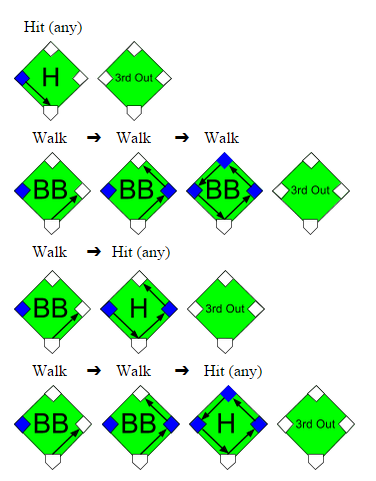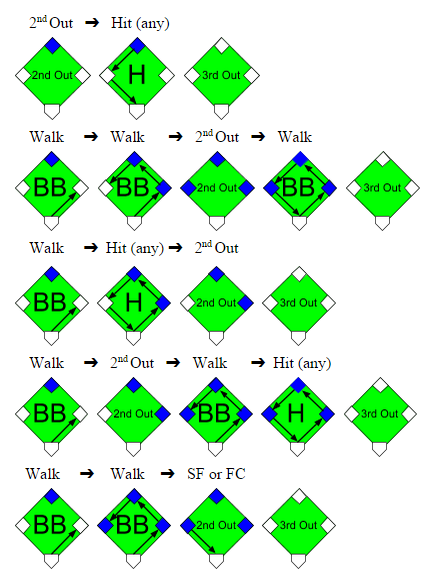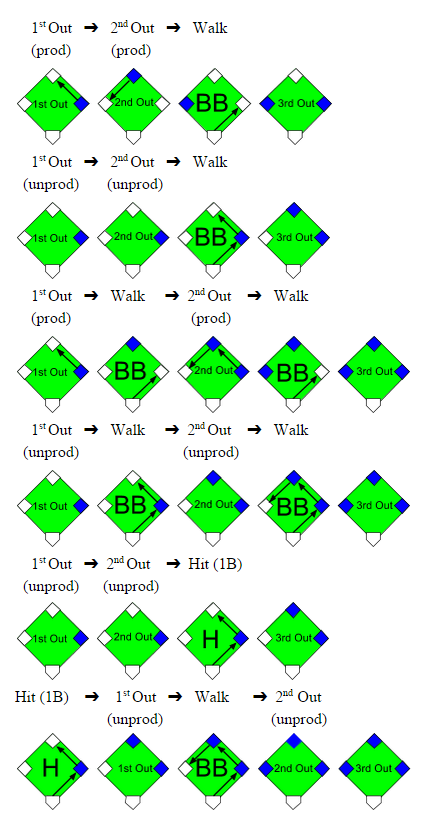So here’s the deal. I’ve seen loads of articles with great analysis and research and truthfully, I’d love to be all up in that. I love the nerdy side of the game and wish I could quote and analyse the tiniest statistics. I have great admiration for those who do. But the simple fact is I’m not that type of guy. Maybe I can’t comprehend certain stats and figures bounded about in modern baseball society. It could be I don’t have enough time to commit to breaking through in this field. Or simply it’s a case that I lack the “get up and go” as my old teachers used to say. I like to think it’s a combination of factors which contribute to me having never published an article of any kind, anywhere, ever. But here we are, I’m ready to do it, just not in the traditional sense some of you more avid fans would have become accustomed to…….
A little background first. I’m 31, born and raised in London, England and have been a big baseball fan for well over a decade. I like to think I have read and watched enough about the history of the sport and the current state of the game to be able to hold my own in any conversation with more baseball educated fellows. I started playing fantasy baseball 3 years ago after being randomly invited to join a long standing league by someone in a mock draft and have been hooked ever since. My winters are spent plotting my draft tactic and reading countless articles to help me draft my dream team. My rankings are done by Christmas and altered ad-nauseam until spring commences before the draft day hits the day the season starts. And here we are, at the reason I have taken time out of my working day private life to write this article. What on Earth was I thinking during the draft?!?!?!
Our league is standard scoring categories, snake re-draft with standard 25 man rosters and is Head-to-Head (which I know some experts detest but for the more casual yet serious player, I like it). And this year expanded to twelve teams from the usual ten. I was sat there with my rankings, myriad spreadsheets and utilities ready to complete the perfect draft. I set myself three clear and concise rules;
- Do not draft too many players from one team. Reasoning is quite personal but I feel if there’s a team wide issue causing a slump and you have three or four guys from that team, the impact could be huge. I carried this over from my Chicago Bears Fantasy Football disaster a year ago.
- Do not draft a pitcher in the first 6 rounds. I had spent a massive portion of my research looking at guys I can get pretty late to form a strong pitching core and had enough confidence in myself to execute this successfully.
- Only draft closers guaranteed the role. This league has a stronger emphasis on closers as one or two teams will only draft relievers, nearly guaranteeing them WHIP, ERA and Saves whilst punting Wins and K’s which means relievers are generally drafted way too early (I’ll maybe do a write up on this one day but one step at a time huh).
With all this in mind, I logged on, found I was the 10th pick and wasn’t too bothered. Hey, I was that confident I could have missed the first round pick altogether and still put together a title winning team. Thirty minutes and three picks into the draft, I had Edwin Encarnacion, Jose Bautista and Stephen Strasburg. A couple more hours had passed, and I owned Dellin Betances in the 9th round and Ken Giles in the 17th. Well done dude, that’s two of the three rules out the window but as long as you don’t draft any more Blue Jays, this is salvageable. By the end of round 22, I had Dalton Pompey and Drew Hutchison rostered. I sit here now as a Devon Travis and Miguel Castro owner to boot.
So how did it come to this I now ask myself? Why do I have 6 Blue Jays, a 3rd round pitcher and two relievers who don’t close, one of which came to me in the 9th round?!?!?! AAARRRRRGGGGGGHHHHHHHH
Well it’s pretty simple really; something I like to call Fantasy Dynamics. No doubt this phrase has been used the world over, but I think it’s apt here. This is the part of the article where I try to put over some wisdom and insight. Why have I put these self-imposed rules in place and why have I proceeded to break them with no more than a “how do you do”?
Best place to start is Rule 1; Do not draft too many players from one team; I wanted power early in the draft, get power guys early and cheap speed later, so with Encarnacion still out there after the first 9 picks, he kinda just fell into my lap. It was either him, Abreu or Rizzo and his back injury in spring aside, I felt Encarnacion was the safest bet with his track record for continued elite power. Abreu and Rizzo actually went in the next two picks and so onto my second pick, 15th overall. More power I cried, I NEED MORE POWER. Ah look, Jose Bautista is still out there, he’ll do.
So without even fathoming my rules, within two minutes I had two Blue Jays. But I wasn’t bothered at this point. They served my purpose of getting elite power early. Granted, there was a couple of question marks over them but I’m not one for overpaying for the shiny new toy when there’s a perfectly good product on the shelf which does the same thing year in, year out for less. Neither player has much in the way of competition for their place this year and I actually believe the Blue Jays are a very good shout for the AL East so why shouldn’t I own their two best hitters?
As the draft went on, I needed an outfielder and lacked some speed. Ben Revere had been drafted too soon for my taste (152nd overall pick) and by the late teen rounds there wasn’t much in the way of cheap speed. I considered Marisnick, but his playing time concerned me more than Pompey’s, so I plumped for the Toronto native especially given his propensity to run in the Minors.
Then we head into the 22nd round and where I’m looking to pick up some low end starting pitching with upside. As mentioned before, this is a league where two teams ended up drafting only relievers which meant some SPs were going a lot later than expected. None more so than Drew Hutchison, someone I’d looked at in detail over the Winter and had warmed to considerably to fill the role of a low price, high upside pitcher. The fact his ADP was around the 220 mark and this was the 255th pick overall, I had to pull the trigger. His upside at this price to too high to ignore, especially considering Bud Norris went in the same round. And then there were 4 Blue Jays!
So the end of the draft, I have 4 guys rostered who play north of the border. That’s cool, not the end of the world. And then the season begins and who do I have as my middle infielder on opening day…….Danny Santana. Now I really hated this guy going into the draft and was raging at the fact it was me who drafted him, but middle infielders were going way sooner than expected and some too soon for my liking (some examples below) so I had to get him to fill a spot if nothing else. So the season starts and I figured, “hey, why not take a chance on Devon Travis”. He’d been named as Toronto’s starting second baseman and in this side, could be productive so why not. That makes it 5 Blue Jays.
Jimmy Rollins ADP 131 Selected 71st overall -60
Alcides Escobar ADP 176 Selected 132nd overall -44
Daniel Murphy ADP 142 Selected 109th overall -33
Scooter Gennett ADP 220 Selected 187th overall -33
Closing the end of the season’s first week, the news breaks that Brett Cecil is out as Toronto’s closer and John Gibbons’ faith is being thrust onto Miguel Castro, a 20 year old upstart who was so under the radar, I couldn’t even find any information about him pre-season. But this is a league where closers are gold-dust and I was first to find this information out (thanks Twitter). So there I was, 6 Blue Jays just one week into the season. Rule 1, thanks for playing but goodbye.
But I could justify it to myself, I went power early, needed a speedy outfielder late, really liked Drew Hutchison, hated Danny Santana and had the chance for another bit of gold closer. So it’s not all bad, right. Granted a couple of the picks haven’t worked out early doors (I’m looking at you Drew and Jose’s shoulder) but looking back, I’m not sure there’s a whole lot I would have done differently given the same set of circumstances. With hindsight, maybe, but as Helen Reddy once said “Hindsight is wonderful. It’s always very easy to second guess after the fact”.
Then Rule 2; Do not draft a pitcher in the first 6 rounds. I had no need to, I’ll load up power early, get a couple of SP2 types around the 7th and 8th rounds and then draft the best player in the need I had. Simple. Until I got to my 3rd round pick (no 34 overall). I had already seen 6 SPs drafted at this point (Kershaw, Felix, Scherzer, Sale, Bumgarner and Price) but no one seemed to want Stephen Strasburg to this point. Why? I thought he’d take another step this year to being the ace he is already and would have been snapped up by now. But he wasn’t. I couldn’t chance he’d still be there by my next pick so why risk the wait? I had to do it, I just had to. And I did. Ta-Da, Rule 2 is outta here.
So why did I do it, what possible justification could I give myself for doing it? Well, it’s simple. I thought he was undervalued and was the best player available at the time of my pick. I could still achieve my target of stocking up with power early and now had an ace. I wouldn’t need two SP2 types, I’d only need the one and could easily bag some decent pop around the 6th, 7th and 8th rounds so this is a good thing. I’ve done something I didn’t want to and it should actually make my team better now, so yay me!
And then Rule 3; Only draft closers guaranteed the role. By the time of my 9th round pick (106th overall) I had the power I needed, had the two starters I wanted and only had a gap at shortstop which at the time, I figured I could fill in easily (hindsight again). Nine (count ‘em NINE) closers had been drafted at this point. I couldn’t sit on the fence any longer, knowing closers were disappearing faster than donuts at Homer Simpson’s house. So who could I get? The elite ones had gone; the next tier of guys had been drained. Or had they? Dellin Betances was still waiting for a roster spot. All the talk from the Yankees was a committee, Andrew Miller could be taking saves away but Betances was so good last year, is a righty with great stuff. He’d get the job sooner rather than later all to himself. Let’s do this.
I had no regrets, of course Betances will be closing, its a shoe-in. So by the time my 17th round pick arrives (202 overall), I figured it’s a good time to pick up another guy who can get me saves. By now, 31 relievers had been drafted, but Ken Giles was not one of them. The Phillies are desperate to cut ties with Papelbon and Giles is next up. They’ll find a buyer for Papelbon within the first week of the season. Papelbon doesn’t want to be in Philadelphia anymore. Papelbon will be gone within a week. Papelbon, PAPELBON, PAPELBONNNNNNNN………………
I was sure I had now got two guys, undervalued in this league that will close, give me plenty of strikeouts and be big factors in my triumph. At the end of the draft, I grinned to myself and was satisfied with my evening’s work. I looked at my “closers” and my grin subsided a little. What about Rule 3? Why have I now got 2 relievers not guaranteed to close?
Well as I mentioned in Betances case, I was so sure of his stuff and makeup, he’d be the full time closer within a couple of weeks. Maybe he’d lose a few saves to Miller during the season but so be it. I’m a Yankee fan (noticed I’ve waited this long to out myself in case any of you stopped reading as soon as I uttered those words). I know Betances will close, Girardi talking about a committee is pre-season bluster. D’oh.
And Ken Giles……well that I’m finding it harder to justify. There’s nothing guaranteed about Papelbon leaving the Phillies any time soon. Any potential buyer has gone silent and until trade deadline day looms, I think he stays put (maybe even beyond). Earlier this week I actually dropped Giles and he’s still sat in free agency which in this league, shows how limited his value has been so far. He’s been nowhere near last season’s level and is pretty much valueless in this league’s format. So well done to me for drafting him.
So that’s my draft day story, 3 simple rules, all of which have been broken. Why have I felt the need to write this? Is it somewhat cathartic? Well yes. But I’m not going to end on a big epiphany. People can take this for what they want it to be. Some of you will come out of this taking nothing away and that’s cool too. But the one thing it’s got me thinking about, is how much more flexible I need to be. When I first started to play, I almost had my team written down before the draft and barring one or two players, I wasn’t far wrong. It was as near to set in stone as could be. All because of my rigid nature in the draft. I’ve gotten better at that, I’m more open to making changes before, during and after the draft, seeking value rather than my overriding desire to own a particular player.
But this year I set myself three rules, based on my own experience, other people’s experience and every bit of research I had done. And yet all 3 still went out the window. Simple rules which won’t impact my plans and ideas, won’t hinder myself in the draft and should guide me to glory. And all I can muster is that flexibility is vital in drafts and during the season, keeping an open mind helps you as much as all the research you do. Don’t make rules you’re willing to break people!
No doubt, there’s much more seasoned Fantasy Baseball players who have read this and thought “what’s the point in this? I know what I’m doing, why should I listen to anything this guy has to say”. Some of you fellow newbies might also think the same, “How dumb is this guy?” But everyone who has ventured into this wonderful world we call Fantasy Baseball can take some sustenance from this, whether you learnt this lesson long ago, or simply don’t care about this and it’s given you something to gripe about, it’s done something.
Despite all of my rule breaking, I’m still happy with my team. It’s pretty much got the same MO as the team I had planned to have and there’s very little I would have done differently without hindsight. I think I can contend this year if I get that essential bit of luck everyone needs to succeed. I think this year could be my year. So let me close with a relevant quote which has some relevance, from my all-time favourite wordsmith; Mr Yogi Berra.
“If you don’t know where you are going, you’ll end up someplace else.”









